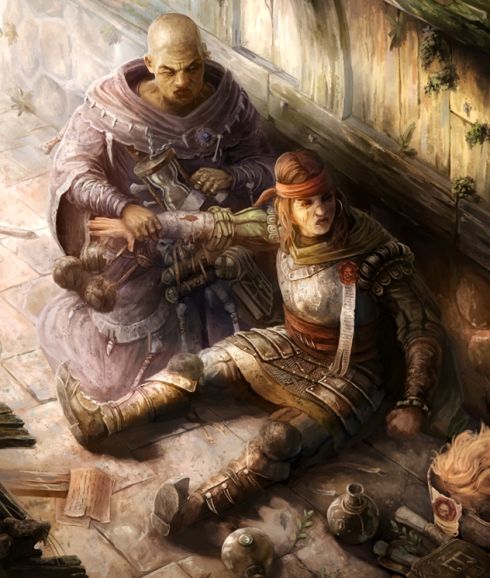Binding Wounds (sage ability)
Binding wounds is an amateur-status sage ability in the studies of Medicine and Animal Physiology, provides a method to staunch damage inflicted by wounds by applying bandages to the injured area.
To execute the procedure, individuals cannot have traits associated with idiocy or imbecility, or be moronic, simply because they're unable to grasp even simple concepts without the physical help of others. This ability also offers some assistance for injuries. Although anyone can bind a wound in three combat rounds, characters with this sage ability can bind wounds more swiftly and effectively, saving considerable time in providing aid.
Methodology
Creatures that are wounded must keep track of how many wounds they've received and how much damage each wound is presently causing. Once any specific wound has been bound for one round, the blood is counted as staunched and no more loss accrues from THAT wound; but others would continue to bleed normally. In each case, the whole necessary must be spent to bind each wound, or else once the binding stops the wound begins to bleed as freshly as before. If that should happen, then the binding process must begin anew, as though no previous effort was made.
This can happen if the binding character is stunned or otherwise prevented from their good work. In some cases, each round may count where the patient's survival is concerned. Up to three characters, trained or otherwise, may participate on a single patient in binding wounds; if all possess the binding wounds ability, up to four may do so.
Time Needed
For unskilled persons, binding a wound that causes 1 hit point of damage per round takes three rounds to bind, once the bandage is in hand. It's important not to waste time hunting for bandages. For each additional point of severity a wound has (say, causing 2 damage per round instead of 1), an addition two rounds is needed to completely bind that wound (5 rounds altogether).
If, however, the character has this sage ability, the time needed for 1 point of wound is two rounds, not three. Moroever, each additional point of severity only requires a single additional round. Thus, what an unskilled person takes 5 rounds to accomplish, a skilled person can do in three.
Binding with Care
If the skilled character has plenty of time, and chooses to spend double the time to bind the patient's wound, 1 point of wound damage can be restored. This cannot be done by an unskilled character. If the binding began before the patient suffered any damage, the point wasn't lost and therefore cannot be restored.
Bandages
Proper bandages are available for purchase at most markets, typically crafted from soft fibers like pulled cotton, wool, or linen. It's assumed that characters take precautions to keep these bandages clean, though they can be damaged by water, fire and similar hazards.
In desperate moments, any loose piece of cloth can be used, which can be torn from clothing that isn't tightly fitted to the body — unless there's time to actually remove a shirt, vest, pants, etc. The cloth must be light, however, as heavy cloth, such as oilcloth or that used for padded armour, cannot be employed as a bandage due to its thickness and rigidity.
However, an ordinary cloth dressing is improper, as it may be partly soiled. There's a chance that a disease may develop, unless the cloth is replaced with a proper dressing made of clean bandages within an hour. The likelihood of a random disease occurring when an improper dressing is left in place, and not changed, is 1 in 30.
Injuries
The ability also provides the character with an ability to manage injuries, particularly breaks in limbs, so that the patient is able to marginally function. The character can identify the nature of the injury and what's wrong, so that its effect can be mitigated to the greatest degree with materials available, depending upon conditions.
See Also,
Combat
